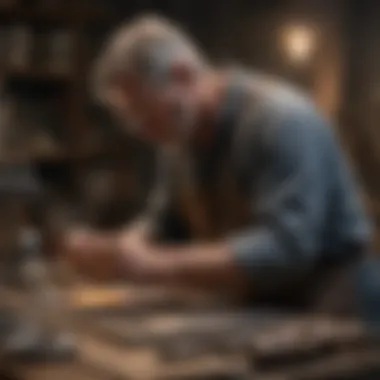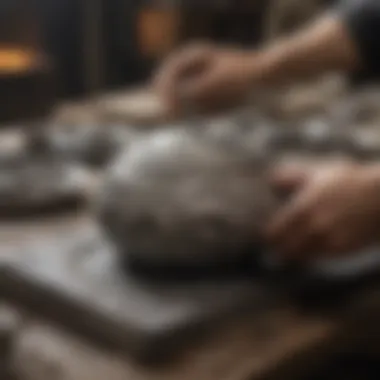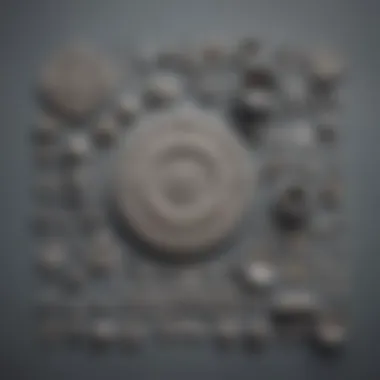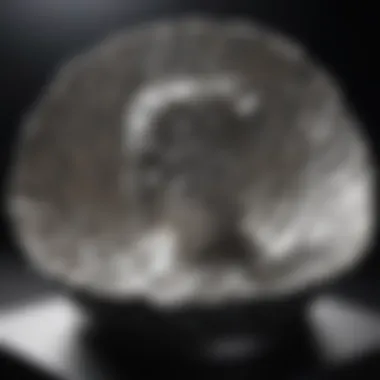Unveiling the Mastery of Silver Casting: A Definitive Guide to Silver Casting Kits


Rock and Fossil Identification
When embarking on the enthralling journey of silver casting, it is essential to familiarize oneself with the fundamentals of this ancient art. Understanding the properties of silver, the intricacies of the casting process, and the tools involved lays a robust foundation for success. Delving deeper into the realm of silver casting unveils a mesmerizing combination of precision and artistry, where enthusiasts and beginners converge to create stunning pieces that reflect both skill and creativity. Embrace the intricate world of silver casting as we explore the realm of silver casting kits, demystifying their components and unraveling the secrets behind crafting exquisite silver creations. Get ready to embark on a voyage of craftsmanship, where every detail matters and every creation is a masterpiece in its own right.
Types of Rocks and Fossils
In the realm of silver casting, akin to the diverse array of rocks and fossils in the geological world, silver comes in various forms and compositions. From sterling silver to fine silver, each possesses unique characteristics that influence their suitability for different casting techniques. Understanding the distinct properties of these silver types empowers artisans to make informed choices that enhance the final outcome of their creations. Just as in rock and fossil identification, where keen observation is key, in silver casting, discerning the nuances between different silver alloys is paramount. Explore the realms of sterling silver's durability, fine silver's purity, and the potential of other silver alloys, unlocking a world of possibilities for crafting silver masterpieces.
Characteristics to Look For
Much like identifying key features in rocks and fossils, in silver casting, attention to detail is crucial. The characteristics of silver, such as its malleability, ductility, and resistance to tarnishing, dictate the feasibility of molding it into intricate designs. Just as collectors search for unique patterns and textures in rocks and fossils, artisans seek specific qualities in silver that will enable them to achieve the desired finish and structure in their creations. As you delve into the art of silver casting, hone your skills in recognizing the subtle signs that distinguish high-quality silver, ensuring that your pieces not only dazzle with brilliance but also stand the test of time.
Tools for Identification
Just as geologists rely on specialized tools for rock and fossil identification, silver casters equip themselves with a plethora of instruments to aid them in their craft. From crucibles and casting molds to torches and polishing materials, each tool plays a vital role in shaping silver into exquisite forms. Understanding the purpose and proper usage of these tools is akin to mastering the techniques of rock and fossil analysis, where precision and accuracy are paramount. This comprehensive guide to silver casting kits will not only demystify the function of each tool but also provide invaluable insights on how to leverage them effectively to create captivating silver pieces. Equip yourself with the right tools, sharpen your skills, and venture into the captivating world of silver casting with confidence and creativity.
Introduction to Silver Gusitn
In the vast expanse of art and craftsmanship, silver casting stands out as a venerable technique that has captivated artisans and enthusiasts for generations. This section serves as a gateway into the intricate realm of silver casting, laying the foundation for understanding its nuances and significance in the world of artistic expression.
Understanding the Art of Silver Gusitn
History of Silver Gusitn
The history of silver casting dates back centuries, intertwining with the rich tapestry of human civilization. From ancient civilizations to modern times, silver casting has played a vital role in cultural heritage and artistic endeavors. The allure of silver's malleability and shimmering beauty has been a driving force behind the enduring popularity of this art form. Exploring the historical evolution of silver casting provides insight into its enduring relevance and timeless appeal to artisans and collectors alike.
Benefits of Silver Gusitn
Silver casting offers a plethora of benefits for artists and craftspeople alike. The versatility of silver as a medium allows for the creation of intricate and exquisite designs that can adorn jewelry, sculptures, and decorative pieces. Its durability and luster further enhance the appeal of silver casting, making it a favored choice for those seeking enduring beauty in their creations. Understanding the advantages of silver casting sheds light on why it remains a cornerstone of artistic expression in various creative spheres.
Applications in Modern Rat
In the contemporary art world, silver casting continues to find new and innovative applications. From bespoke jewelry designs to avant-garde sculptures, the adaptability of silver as a casting material opens up a world of possibilities for artists pushing the boundaries of creativity. The integration of traditional silver casting techniques with modern artistic sensibilities showcases the enduring relevance and adaptability of this time-honored craft in the ever-evolving landscape of art and design.
Essential Tools and Matsrials
Crucible and Snotg
Central to the process of silver casting are the crucible and tongs, essential tools that enable artisans to melt and pour silver with precision and control. The crucible's heat-resistant properties and the tongs' ability to safely handle molten metal are indispensable in the casting process. Understanding the pivotal role of these tools in shaping molten silver into intricate forms underscores their importance in the hands of skilled craftsmen.
Silver Ayloys and Flix


The selection of silver alloys and flux is a critical aspect of silver casting, influencing the final look and quality of the cast piece. Different alloys offer varying degrees of hardness, color, and durability, allowing artisans to tailor their creations to specific requirements. Flux, on the other hand, serves as a cleaning agent, removing oxides and impurities to ensure a flawless casting process. Delving into the world of silver alloys and flux unveils a realm of creative possibilities for crafting exquisite silver pieces.
Molds and Casting Patternsy
Molds and casting patterns form the backbone of silver casting, dictating the shape and texture of the final piece. Whether utilizing traditional molds or exploring innovative casting patterns, artisans have the opportunity to infuse their creations with unique characteristics and intricate details. The art of mold-making and pattern design plays a crucial role in translating artistic vision into tangible silver creations, highlighting the marriage of artistry and craftsmanship in the realm of silver casting.
Safety Precautions for Silver Gusitn
Ventilation and Protective Grear
When engaging in silver casting, adequate ventilation and protective gear are paramount to ensure the safety of artisans. Proper ventilation helps disperse fumes and gases generated during the casting process, safeguarding against potential health risks. Additionally, wearing appropriate protective gear such as gloves and aprons shields artisans from burns and injuries, allowing them to work with molten silver confidently and securely. Prioritizing ventilation and protective measures underscores the commitment to safety and well-being in the practice of silver casting.
Fire Sfety Mearsures
Fire safety measures form a critical component of silver casting protocols, mitigating the risk of fire hazards in the workspace. Maintaining a clear and designated work area, equipped with fire extinguishers and emergency protocols, minimizes the likelihood of accidents during the casting process. Understanding fire safety best practices and implementing precautionary measures lay the foundation for a secure and controlled casting environment, ensuring the protection of both artisans and their artistic creations.
Handling Motlen Silver
The handling of molten silver requires precision, caution, and attentiveness to prevent accidents and ensure smooth casting operations. Properly managing the pouring and manipulation of molten silver demands steady hands, focus, and adherence to established safety guidelines. The art of handling molten silver goes beyond technical skill; it embodies a respect for the material's transformative power and the mastery of its fluid properties. A meticulous approach to handling molten silver guarantees not only the successful realization of artistic vision but also the safety and well-being of artisans engaged in the craft.
Choosing the Right Silver Casting Kit
When delving into the world of silver casting, one of the most crucial decisions a craftsman makes is selecting the appropriate silver casting kit. The process of choosing the right kit is akin to an artist selecting the perfect brush - it sets the stage for the entire creative endeavor. A novice may find themselves overwhelmed by the plethora of options available in the market, but fear not, for this guide elucidates the key considerations to streamline your decision-making process.
Factors to Consider
Quality of Materials
Quality of materials is the bedrock upon which the edifice of silver casting stands. Opting for kits crafted from premium materials not only ensures durability but also guarantees impeccable results. The castings produced reflect the innate quality of the materials employed, making this aspect a cornerstone of successful silver casting. Embracing kits fashioned from top-tier materials facilitates a seamless casting experience, enriching the journey from molten metal to exquisite creation.
Compatibility with Silver Alloys
The interplay between the kit and silver alloys is crucial for a harmonious casting process. A kit's compatibility with various silver alloys enhances flexibility, permitting artisans to explore the full spectrum of possibilities. Selecting a kit adept at accommodating different silver alloys empowers craftsmen to experiment and innovate, pushing the boundaries of traditional silver casting. This compatibility factor unleashes a realm of creativity, fostering a dynamic and enriching casting environment.
User-Friendly Design
In the labyrinth of silver casting, a user-friendly design serves as a guiding beacon, illuminating the path for both newcomers and seasoned veterans. Kits outfitted with user-friendly features exhibit intuitive layouts, streamlined processes, and ergonomic considerations, culminating in a seamless casting experience. A design that prioritizes user convenience lessens barriers to creativity, enabling artisans to focus on honing their craft rather than wrestling with complex tools. Embrace a kit that marries functionality with ease of use, and watch your casting journey unfold with unrivaled fluidity.
Popular Silver Casting Kits
Embark on a tour of the most sought-after silver casting kits, each offering a unique array of features and benefits to elevate your casting experience to new heights.
Brand A Kit Features


Unveil the exquisite features of Brand A's silver casting kit, meticulously crafted to cater to the discerning needs of artisans. From specially designed crucibles to precision-engineered tongs, every facet of this kit exudes excellence. Dive into a realm where attention to detail reigns supreme, ensuring that every casting session is a symphony of artistry and precision.
Brand B Kit Specifications
Explore the technical prowess of Brand B's silver casting kit, where specifications meet innovation to redefine the boundaries of possibility. With a focus on enhancing versatility and performance, this kit stands as a testament to engineering ingenuity. Immerse yourself in a world where specifications pave the way for seamless casting experiences, offering unparalleled control and accuracy.
Brand Kit Benefits
Delve into the myriad benefits encapsulated within Brand C's silver casting kit, a treasure trove of advantages waiting to be unlocked. From user-centric features that streamline the casting process to innovative design elements that foster creativity, this kit is a catalyst for artistic exploration. Uncover a wealth of benefits that transform silver casting from a craft into an immersive journey of self-expression and craftsmanship.
Mastering Silver Casting Techniques
In the realm of silver casting, mastering techniques holds paramount importance as it sets the foundation for creating intricate and flawless silver pieces. The dedication to understanding the nuances of silver casting techniques elevates the quality of artwork produced. By focusing on mastering silver casting techniques, artisans can achieve precision, consistency, and attention to detail in their creations. This section delves into the core elements that contribute to mastering silver casting techniques, emphasizing the significance of honing skills to craft exquisite silver pieces.
Step-by-Step Guide
Preparing the Mold
Preparing the mold is a critical step in the silver casting process, laying the groundwork for the final piece's shape and details. The meticulous preparation of the mold ensures that the silver is poured into a well-defined space, resulting in accurate and aesthetically pleasing outcomes. One key characteristic of preparing the mold is the use of high-quality materials that can withstand the heat of molten silver, facilitating a smooth casting process. This method's beneficial aspect lies in its ability to capture intricate designs and textures, adding depth and complexity to the final silver piece. However, a disadvantage of this process could be the time-intensive nature of creating detailed molds, requiring patience and precision from the artisan to achieve desired results.
Melting and Pouring Silver
Melting and pouring silver are pivotal stages in the silver casting journey, where the transformation from solid metal to molten liquid takes place. The process of melting silver involves heating the metal to its melting point within a crucible, ensuring a homogenous liquid state for casting. The key characteristic of this stage is the controlled pouring of molten silver into the prepared mold, dictating the final shape and structure of the silver piece. This method's popularity stems from its versatility and adaptability in shaping various designs and forms, offering artists flexibility in their creative expression. However, a challenge in melting and pouring silver lies in maintaining the optimal temperature and consistency throughout the process, requiring skillful handling and monitoring by the artisan.
Finishing and Polishing
Finishing and polishing mark the final steps in the silver casting process, enhancing the visual appeal and quality of the completed piece. The meticulous finishing of the silver surface ensures a smooth texture and refined appearance, highlighting the intricate details and designs embedded in the metal. A key characteristic of finishing and polishing is the use of specialized tools and techniques to buff, polish, and refine the silver surface to achieve a captivating luster and shine. This approach's benefit lies in its ability to elevate the overall aesthetics of the silver artwork, creating a polished and professional finish. However, a challenge during finishing and polishing is the risk of over-polishing, which can diminish details and textures, underscoring the importance of careful craftsmanship and attention to detail.
Advanced Tips and Tricks
Creating Intricate Designs
Creating intricate designs allows artisans to push the boundaries of traditional silver casting, unleashing their creativity and artistic vision. This aspect contributes to the overall innovation and uniqueness of silver pieces, showcasing intricate patterns, textures, and shapes that captivate viewers. The key characteristic of creating intricate designs is the fusion of traditional techniques with modern aesthetics, resulting in one-of-a-kind silver creations that stand out. This approach's advantages include the ability to personalize and customize silver pieces according to individual preferences, offering a unique and personalized touch to each artwork. However, a potential drawback of creating intricate designs is the meticulous attention to detail required, demanding patience and precision from the artisan to achieve desired outcomes.
Troubleshooting Common Issues
Troubleshooting common issues is a crucial skill set for silver casters to overcome challenges and obstacles encountered during the casting process. Addressing common issues such as porosity, shrinkage, or metal impurities ensures the quality and integrity of the final silver pieces. The key characteristic of troubleshooting common issues is the ability to identify root causes and implement effective solutions to rectify casting flaws. This method's popularity lies in its capacity to enhance craftsmanship and problem-solving skills, enabling artisans to produce high-quality silver artworks consistently. However, a challenge in troubleshooting common issues is the complexity of diagnosing and resolving casting defects, requiring expertise and experience to navigate and mitigate potential setbacks.
Experimenting with Different Textures
Experimenting with different textures broadens the creative horizons of silver casting, offering artists the opportunity to explore diverse tactile elements and visual effects. The incorporation of varied textures, whether smooth, rough, or textured, adds dimension and interest to silver pieces, creating dynamic and engaging artworks. The key characteristic of experimenting with different textures is the freedom to play with contrasting surfaces and finishes, introducing depth and character to the final silver composition. This approach's advantages include the versatility to evoke various emotions and themes through texture manipulation, allowing for artistic experimentation and innovation. However, a challenge in experimenting with different textures is achieving a harmonious balance between contrasting elements, requiring skillful execution and a discerning eye for aesthetic cohesion.
Exploring Silver Casting Creativity


In this captivating section of the comprehensive guide to silver casting kits, we delve into the realm of exploration and creativity that defines the art of silver casting. Understanding and engaging with silver casting creativity not only adds a layer of artistry to the process but also opens up endless possibilities for enthusiasts and beginners looking to elevate their craftsmanship. The importance of this topic lies in its ability to inspire innovation, showcase individuality, and push the boundaries of traditional silver casting techniques.
Innovative Silver Casting Projects
Artistic Jewelry Pieces
Discussing the unique allure of artistic jewelry pieces within the context of silver casting brings to light the intricate fusion of elegance and craftsmanship. These pieces play a pivotal role in accentuating the beauty of silver while allowing artisans to express their creativity with finesse. The key characteristic of artistic jewelry pieces lies in their ability to stand as wearable art, blending functionality with artistic expression seamlessly. Their popularity stems from the distinctiveness they bring to any collection, making them a sought-after choice for both creators and collectors alike.
Decorative Home Accents
Exploring the realm of decorative home accents in silver casting showcases the versatility of this art form beyond traditional jewelry making. These accents serve as sophisticated additions to any living space, embodying a harmonious blend of aesthetic appeal and functional design. The key characteristic of decorative home accents lies in their ability to elevate interior décor with a touch of elegance and craftsmanship. Their popularity stems from the transformative effect they have on living spaces, making them a preferred choice for individuals seeking to infuse artistic charm into their homes.
Miniature Sculptures
Delving into the allure of miniature sculptures highlights the meticulous artistry and attention to detail required in silver casting projects. These sculptures serve as enchanting miniaturized representations of larger art forms, carving out a niche for themselves in the realm of three-dimensional art. The key characteristic of miniature sculptures lies in their ability to convey intricate narratives in a compact form, capturing the essence of larger-scale artworks with precision. Their appeal lies in the dexterity required to create them, making them a favorite choice for artists seeking a unique challenge in their silver casting endeavors.
Collaborative Silver Casting Workshops
Community Engagement Events
Community engagement events play a vital role in fostering a sense of camaraderie and shared creativity among silver casting enthusiasts. These events bring together like-minded individuals to exchange ideas, techniques, and inspirations, creating a vibrant platform for collaboration and learning. The key characteristic of community engagement events lies in their ability to build networks, cultivate skills, and spark innovation within the silver casting community. Their popularity stems from the sense of community they nurture, making them an enriching choice for individuals seeking to connect with fellow artisans.
Educational Outreach Programs
Exploring the realm of educational outreach programs sheds light on the transformative power of knowledge and skill-sharing in the field of silver casting. These programs serve as educational platforms for beginners and seasoned practitioners alike to expand their understanding of techniques, tools, and design aesthetics. The key characteristic of educational outreach programs lies in their ability to bridge the gap between theory and practice, equipping participants with practical skills and insights. Their appeal lies in the continuous learning opportunities they provide, making them a valuable choice for individuals keen on honing their craft.
Artisanal Collective Initiatives
Diving into the realm of artisanal collective initiatives underscores the strength and creativity that flourish within collaborative endeavors in silver casting. These initiatives bring together artisans, designers, and enthusiasts to co-create, innovate, and showcase the diverse talents within the community. The key characteristic of artisanal collective initiatives lies in their ability to celebrate diversity, promote inclusivity, and push boundaries through collective creativity. Their appeal lies in the synergy generated by diverse perspectives and skill sets, making them a dynamic choice for individuals seeking to be part of a collaborative and supportive creative ecosystem.
Preserving and Showcasing Silver Castings
In the realm of silver casting, the preservation and display of finished pieces hold significant importance. Preserving silver artwork is not merely about maintenance but also about honouring the craft and artistry involved in the process. It involves a delicate balance of protecting the pieces from external elements while showcasing them in a way that highlights their beauty and craftsmanship.
When it comes to maintaining silver artwork, incorporating proper cleaning and storage practices is paramount. The longevity and luster of silver pieces depend greatly on how well they are cared for. Cleaning silver requires gentle methods to avoid damaging the surface, such as using specialized silver cleaners or mild soaps. Furthermore, proper storage – away from moisture and direct sunlight – helps prevent tarnishing and maintains the brilliance of the metal.
On the aspect of preventing tarnishing, techniques such as using anti-tarnish strips or storing silver in anti-tarnish bags play a vital role. Tarnishing, a natural process of oxidation, can diminish the shine of silver if left unchecked. By implementing preventive measures, like regular cleaning and applying protective coatings, tarnishing can be minimized, ensuring the pieces retain their exquisite appearance over time.
Displaying silver collections is an art form in itself. How silver pieces are showcased can significantly impact how they are perceived. Factors like lighting, background, and arrangement all contribute to the overall presentation. By employing elegant display stands, incorporating creative lighting, and arranging pieces thoughtfully, silver collections can be elevated from mere objects to exquisite works of art.
Appreciating Silver Casting Heritage
Delving into the heritage of silver casting unveils a rich tapestry of historical significance that transcends time. The art of silver casting has been an integral part of various cultures, symbolizing wealth, status, and artistic prowess. Understanding the historical context behind silver casting provides a deeper appreciation for its evolution and impact on society.
The historical significance of silver casting is evident in its use throughout ancient civilizations and its role in shaping trade and craftsmanship. Silver artifacts hold stories of the past, reflecting the skills and aesthetics prevalent in different eras. By studying the historical background of silver casting, enthusiasts gain insights into the cultural practices and societal values that shaped the artform.
The cultural relevance of silver casting is profound, as it embodies traditions, beliefs, and artistic expressions unique to different regions. Silver pieces often carry symbolic meanings deeply rooted in specific cultures, making them more than just decorative items. Exploring the cultural significance of silver casting allows enthusiasts to connect with diverse heritages and appreciate the universal language of art that transcends barriers.
The artistic legacy of silver casting encompasses the influence of master craftsmen, innovative techniques, and groundbreaking designs passed down through generations. By studying the artistic legacy of silver casting, enthusiasts can trace the evolution of styles, from classical motifs to contemporary interpretations. The enduring legacy of silver casting inspires new generations to continue pushing the boundaries of creativity and craftsmanship, ensuring that this ancient artform remains vibrant and relevant in the modern world.







